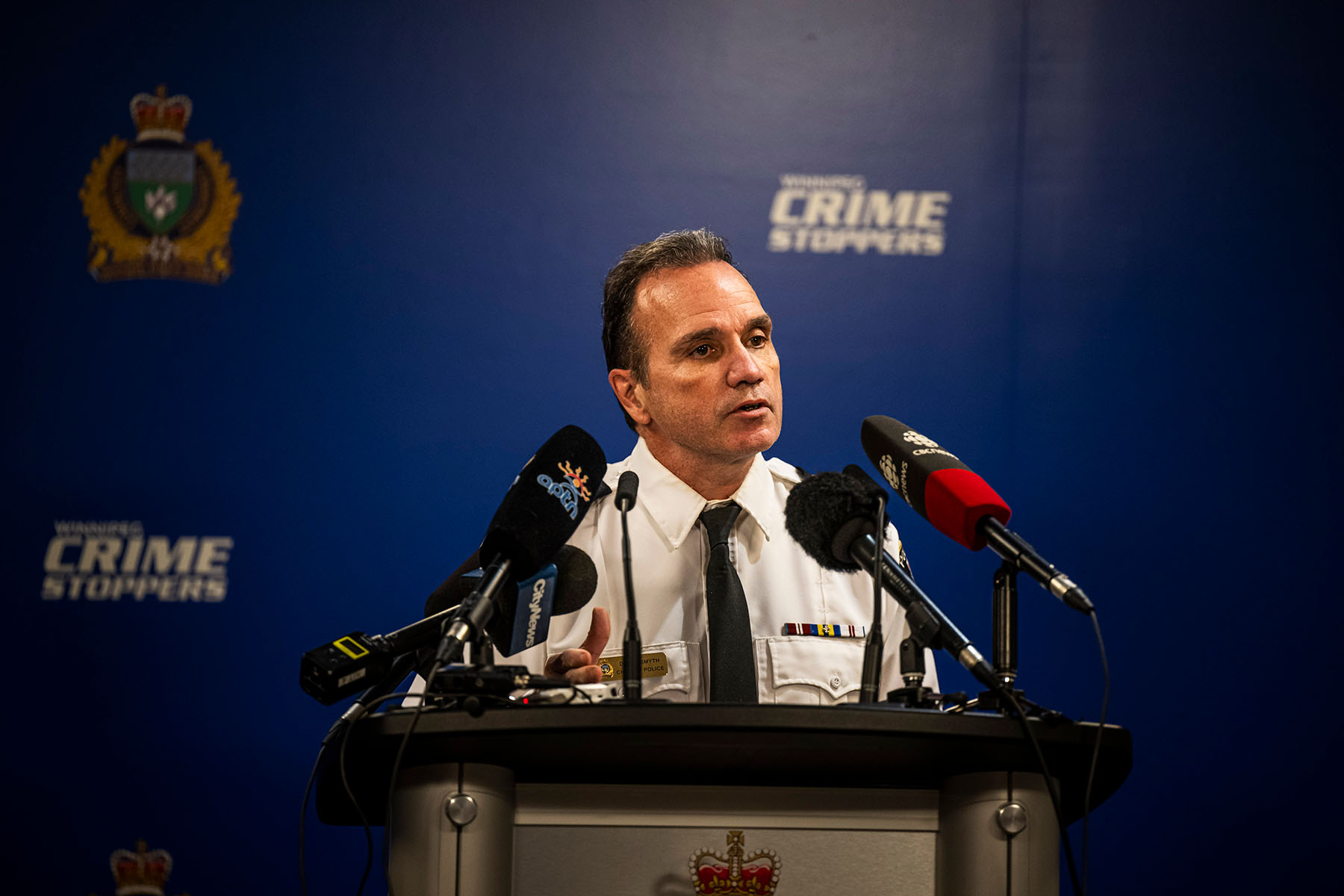If police kept working-class people safe, Winnipeg would be one of the safest cities in Canada, if not the world. The Prairie city of more than 800,000 people now spends more than one quarter of its operating budget on the Winnipeg Police Service—by far the highest share for any major city in the country. The police force is projected to spend more than $330 million in 2024 and $360 million in 2027. Comparatively, the entire Community Services department—which includes all libraries and recreation services such as pools, arenas, and community centres—is budgeted for a measly $110 million by 2027, while the city’s contribution to public transit will reach only $133 million by then.
A vast majority of this police budget goes toward the salaries, benefits, and pensions of a tiny cadre of extremely well-compensated cops. A cop starts making a six-figure salary after only five years on the job. In 2022, about 1,300 WPS employees made more than $100,000 a year, compared to only sixty employees of Winnipeg Transit and twenty-three from Community Services. In total, more than half of the 100 highest-paid city employees belong to the WPS. This situation also means that future wage increases will further inflate already enormous salaries, and that this divide will only widen in the years to come. Meanwhile, life-affirming care goes underfunded, understaffed, and unsupported altogether.
The WPS has also become a national, and even global, leader in advancing new policing technologies and strategies. In 2021, the WPS hastily purchased the dystopian Boston Dynamics robot dog Spot to join its fleet of helicopter, armoured vehicle, and drones, with the WPS drone unit coordinator asking at the time: “Are we the first public safety agency in Canada to be obtaining one? I think we are?” In 2023, the force spent almost $300,000 on artificial intelligence software for video analysis, likely for the purposes of conducting facial recognition scans.
Recently, the force has continued expanding its scope into public spaces like grocery stores, buses, and libraries, as well as collaborating with Winnipeg Jets owner True North Sports & Entertainment (itself co-owned by David Thomson, the richest person in Canada) to create a Downtown Community Safety Partnership that further entrenches policing in a progressive veneer. The city has also become a hub for so-called evidence-based and intelligence-led policing, leveraging the Winnipeg-based Niche Records Management System—used by some of the largest forces in the world, including to file the results of often racist street checks—for the WPS’s Smart Policing Initiative that identifies “hotspots” and “high-risk individuals.” According to the WPS, many other police forces in Canada have reached out about SPI and evidence-based policing to “find out what and how we are doing what we are doing.”
One must also consider the force’s unique and burgeoning communications strategy. Under fire from many sides and dissatisfied with media coverage that it deemed ideological, the WPS launched a Substack in early 2022, titled “Tried and True,” to directly share copaganda largely attributed to then chief Danny Smyth (who retired earlier this month); posts have so far included denouncing an anti-racist researcher for his report critical of cops in schools, defending the robot dog purchase, attempting to discredit witnesses and media coverage of police violence, and detailing Smyth’s visit to Israel as part of a police academy tour facilitated by a Zionist organization.
A feature in The Walrus pointed to this Substack as the leading example of “how police are using PR to combat criticism,” calling it “the only one of its kind” and noting that no other force—not even in the US—has “as personal an approach as the Winnipeg police.” The WPS is playing a nationally important political role as well; Smyth leveraged his beloved Substack and two-year presidency of the Canadian Association of Chiefs of Police to battle for a further tightening of the country’s already draconian bail system.
The present strength and scope of the WPS must be specifically understood as constructed through the targeted policing of Indigenous peoples, who are surviving the intersecting and ongoing violence of land theft, family/community separation, severe underfunding of basic services, state-produced poverty, and much else.
Winnipeg now has the largest urban population of Indigenous people in the country, becoming the first city to pass the 100,000-resident mark in 2021, followed by Edmonton and Vancouver. This vastly disproportionate policing of Indigenous peoples has been embedded in the force since its beginnings in 1874. Its first chief, John Ingram, was appointed to the position due, in large part, to his arrest of Ambrose Lepine, military leader of Louis Riel’s provisional government, with the city’s first mayor, Francis Cornish (a “belligerent bigoted drunk”), even receiving a share of the reward for his own role in coordinating the arrest and prosecution. Historian Megan Kozminski wrote that “during the earliest years of the city’s history, the police perceived the activities and behaviour of the local Métis population as most offensive and threatening to urban order,” with “half breed” the most common nationality of people arrested in 1879 and 1880.
Indigenous peoples have always lived in the area that is now Winnipeg. However, many more moved to the city in the postwar period. Highly targeted police harassment and repression escalated in reaction to increasing numbers of urban Indigenous residents. This included reports of notorious Starlight Tours, in which cops drop off and leave Indigenous people on the outskirts of the city, often in lethal cold. In the fall of 1962, a report by the Winnipeg Police Commission described part of the North End as a problem area that had allegedly worsened with the arrival “of more persons of Indian racial origin” and the creation of “an Indian and Metis community,” resulting in “over 100 persons, mostly Indians” arrested in the area that year. Indigenous people have constantly been treated by the police force as out of place, with cops securing what geographer Owen Toews has described as urban apartheid, by “cleansing certain spaces and containing ‘disorderly’ people in other spaces.”
Unsurprisingly, this forcible process of cleansing and containing Indigenous people has frequently ended in killings. There’s been a staggering amount of death and injury caused by the WPS in recent years, from shootings, tasers, beatings, arrests, and in-custody mistreatment and neglect.
For every such reported police attack, there are countless more manifestations of the terror of the mundane and quotidian: beatings, harassment, intimidation and threats, racial profiling, surveillance, slurs and insults, humiliation and degradation, theft, and more. Much of this happens through racist stops, carding, spot checks, and release conditions like curfew or compliance checks. For instance, when interviewed, Indigenous men report being regularly stopped by police and asked to account for themselves. When the men ask, “What did I do wrong?” the typical response is “You fit the description,” because police are looking for an Indigenous man as a suspect in a crime. In other words, the men are stopped precisely because they are Indigenous.
Such racist discrimination has resulted in severe distrust and avoidance of interaction with the WPS. A 2021 survey by the Southern Chiefs’ Organization found that “more than sixty-six per cent of respondents reported that they have actively avoided seeking help from police in Manitoba due to the effects of racism.” Interviews with Indigenous women in Lord Selkirk Park, a North End public housing complex, found that “they rarely report anything to the police,” as “they do not trust the police and see them as an alien force.”
Similarly, talking circles hosted with Indigenous and Black youth in Winnipeg reported that experiences of police-initiated violence have “led some youth to avoid the police, even when they are in danger and in dire situations.” This tendency is especially important to consider given that oppressed and abandoned communities are most at risk of victimization and are frequently at the forefront of demanding actual safety, yet politicians cynically weaponize their circumstances to justify even more funding of police and the punishment bureaucracy.
The massive expansion of jailing over the past several decades has led to the second highest per capita incarceration rate of all provinces, with Indigenous people making up more than three quarters of Manitoba’s prisoner population. Further, a full three quarters of incarcerated people in the province are in pre-trial detention and are thus legally innocent for the crimes they have been alleged to have committed. Remand, like sentenced custody, is often lethal, with many people dying while awaiting trial. Most of those killed in jails, prisons, and detention centres—including two dozen prisoners in the Stony Mountain federal prison in a recent four-year stretch—are Indigenous.
Ironically, such blatant failures are used in order to hijack an ever greater share of public spending. For instance, in his appeal for a budget of more than $326 million in 2023, Smyth claimed: “We are limited by resources. Clearly, if we had more resources, I think we would have a bigger impact.”
This sleight of hand is an endless feedback loop of rewarding failure: if police-reported crime rates go down, they are leveraged as proof that policing works and that police deserve more money, while if these rates go up, they become evidence of insufficient funding and resources. Either way, the cops maintain their chokehold on public spending—yet have the audacity to blame entirely predictable outcomes on the lack of broader social supports such as mental health resources, as if their greed weren’t a direct contributor to such underfunding. Regardless of material realities, police continue to secure massive budget increases while almost every service necessity crumbles due to defunding and neglect.
There could possibly be a case made for such growth and municipal budgeting if there were any indication that policing was actually improving safety. But the reality is the exact opposite. Although crime statistics must always be treated skeptically given the highly subjective nature of what constitutes a crime that is reported and responded to, it’s incontrovertible that people remain regularly subjected to violence and harm, especially poor and racialized people.
Not counting police killings, there have been at least forty homicides a year in Winnipeg since 2019, including a record high of fifty-three in 2022, along with many violent attacks in buses, libraries, and other popular public spaces. A fascist serial killer with a lengthy history of domestic violence preyed on and murdered at least four Indigenous women—Mashkode Bizhiki’ikwe (Buffalo Woman), Morgan Harris, Marcedes Myran, and Rebecca Contois—in early 2022: an atrocious but all too predictable manifestation of the broader crisis of missing and murdered Indigenous women, girls, and two-spirit people.
The WPS is thus a case study of sorts demonstrating an argument that has long been made and that is now embraced by growing numbers around the world: that policing does not actually create safety but instead destroys the people, communities, and conditions necessary for real and lasting safety. The WPS radically reduces safety and worsens cycles of violence and harm, especially for people already oppressed and marginalized.
Adapted and excerpted from Dogged and Destructive: Essays on the Winnipeg Police by James Wilt, 2024, published by ARP Books. Reprinted with permission from the publisher.





